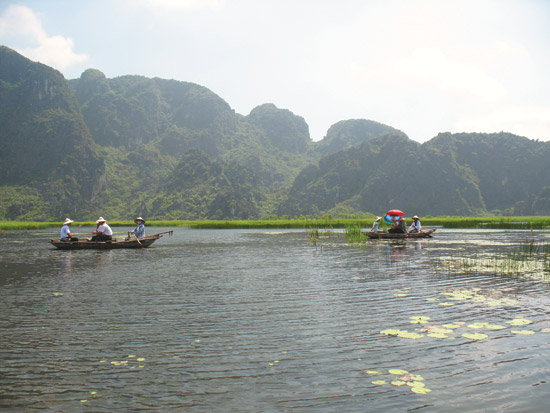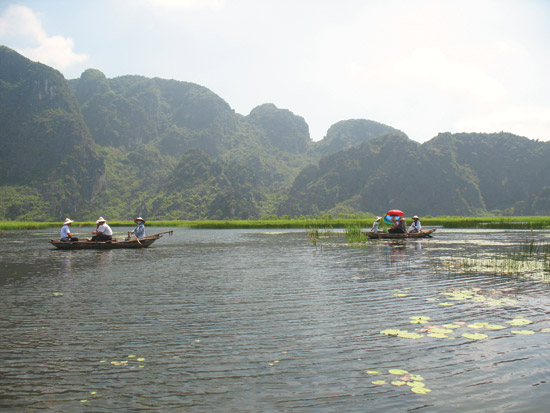(No.5, Vol.3, June 2013 Vietnam Heritage Magazine)
In a vast swamp with the area of about dozen hectares and filled with numerous nutsedge and lotus, there are ‘mysterious’ paintings on a cliff at the innermost corner of Cua Chua Mountain of the Van Long commune, Gia Vien District, Ninh Binh Province, North-eastern Vietnam. Strangely, if any viewers want to see these drawings, they have to sprinkle water onto the cliff’s surface to make them clear enough to see.
Mr Tran Xuan Quang, the man in charge of Van Long Tourist station, took me to Cua Chua Mountain by boat.

Van Long swamp

A researcher works on the pictures
As soon as the boat arrived, Mr Quang quickly used a rubber bucket to scoop water to throw it on the rock, so that I could better view the drawings. However, I reached his hands in time to stop him so that I could have a closer look at the drawings on the cliff.
On the rough surface of the stones, the scribbled, scattered drawings, some on precipitous cliffs, some within reach, appeared indistinct. Beside them were some Han scripts, whose lines were blurred and not orderly as usual.
Mr Quang said that Bai Vong Temple once stood in that spot.
Previously, the painted cliff was behind the temple. A 65-degree slope, the cliff looked like a roof protecting the temple. Over time, the temple degraded and collapsed.
After 1945, some households in the village made use of the flat area, where the foundation had been, to build calciners. These lasted until 1960, when they were demolished.
It was said that during 20th century, the villagers often took shelter from rainstorms under the stone roof when they went seeking for snails in the lake. Strong winds splashed raindrops onto the cliff, making the strange illustrations noticeable in the dark red shade.
With all his might, Mr Quang dashed the water bucket onto the cliff. Like a conjurer’s trick, the dark red glyphs gradually emerged from the white stone walls. Wherever the water ran, they became clearer and bolder. After the water was completely absorbed into the stone’s surface, an image of a man came to view. He had a ferocious face with straight-standing hair and wide eyes, and his expression looked violent and fierce. His right hand was holding a long club, while his left hand was holding a wide-bladed knife. His feet, with shoes on, were stamping on two small men, as if executing them. The man’s face was sketched simply, but his abdomen was drawn in detail, as the organs inside could be seen.
The longer the water stayed, the darker the red drawings became. When I tried hard to rub my hands on the drawing lines, the ink did not come off on my hands. Mr Quang scooped another bucket of water and dashed it onto the drawings.
This time, an illustration of a man with a hat sitting on a chair came out. He was looking at another fierce man who was triumphantly snatching the two small men as if he was about to carry them away for an execution.
Next to it was a sketch of some people who were dancing and cheering. At the bottom were the drawings of many people holding weapons and some groups of people, who seemed to be prisoners of war, terrified and tightly huddled together.
Higher above the first picture was a cluster of scribbles with different sizes in a haphazard position; some of them looked like Han scripts.

A picture after being watered
Mr Quang said as a child, he and his friends often played here and threw stones at the biggest drawing. Afterwards, many people scraped the red ink traces with blunt knives for fun. However, after a long time, when they came back and splashed water onto it, the drawing stayed the same.
According to Mr Quang, elderly people in the village asserted that they had seen these illustrations when they went seeking for crayfish and crabs with their mothers in their childhood.
Master Nguyen Ngoc Luyen, Deputy Director of Culture, Sports and Tourism Department of Ninh Binh province, told me that at first he thought the paintings depicted scenes of an ancient rite which had taken place at Bai Vong temple in the past.
Some scientists suggested that the paintings had religious sense of primitive people as they seemed to be related to the custom of hanging coffins in caves guarding the corpse to show reverence. Otherwise, they believed that the drawing had some connection with sacrificial rites for a water god.
These hypotheses were rejected by Master Nguyen Ngoc Luyen, as beside the drawings were some lines of Han scripts, which were the products of Chinese colonization, not a primitive period.
He guessed that after the Trung sisters’ successful uprising against Han invaders*, the people had depicted the harsh oppressions by Han invaders.
Associate professor and Doctor Trinh Nang Chung, from the Archaeological Institute in Hanoi, went there with some scientists and experts on Han Nom scripts to find out more.
He said the paintings at Van Long were similar to those he saw in Thailand, China and Europe, but it was the first time he saw them in Vietnam. He asserted that the red ink of these drawings was th? hoàng (Yellow Soil) ink, which was popularly used in paintings in the past.
‘Westerners often used this kind of ink to mark on bodies or corpses, both as decorations for the dead and to wish for the souls of the dead to be immortally alive. Th? hoàng red ink was also popular in carved paintings, for primitive people believed that red colour symbolized immortality. In particular, if the ink was mixed with latex or resin of trees, roots and fruits, its colour was very durable.’
Associate professor Trinh Nang Chung, a specialist on Han Nom scripts, said that among the Han scripts on the cliff, the clearest one read ‘grievance’.
‘In the old days, this area was very dreary, with many predators and venomous snakes. Therefore, if someone or some group of people came here to draw the illustrations, it’s psychologically reasonable,’ said associate professor Trinh Nang Chung. ‘According to psychological laws, when frustrated with something which cannot be abreacted or disclosed, people often went to a desert place to pour out their heart. Similarly, the people here, low in social rank and witnessing unfair treatments without any punishments, often turned to the cliff to confide their grievances through these paintings.’
Based on the weapons, he said that the illustrations dated back about 800 – 900 years.
(Editor’s note: The Trung Uprising in 39 AD was initially successful, but eventually put down four years later.)

